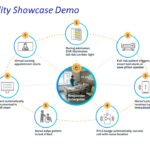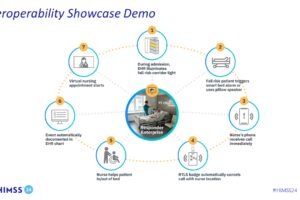 The following is a guest blog post by George Florentine, Vice President of Technology, Flatirons Digital Innovations Inc.
The following is a guest blog post by George Florentine, Vice President of Technology, Flatirons Digital Innovations Inc.
Every year since 2014, there have been more than 100 M&A transactions in healthcare (Source: Kaufman Hall). While M&A is done to reduce costs and maintain competitivity in a fierce market, an offshoot is EHR complexity. As providers come together, they discover that lack of data interoperability between their multiple EHR systems has trapped patient information in EHR silos. This presents a problem for providing patient-centric care, because data silos are obstacles to accessing complete patient information.
Articles in the press confirm the trend. According to Healthcare IT News, “The most popular solution being pursued to address the interoperability challenges that have long plagued healthcare is switching to a single, integrated electronic health record system.” Or, as Health Affairs reports, “A key argument often cited in favor of continued consolidation is improved information sharing by moving to a common electronic health record (EHR) system.”
After all, if all providers in a hospital network use the same EHR, doesn’t it follow that interoperability issues will be reduced or potentially eliminated?
The answer is no, certainly not in the short term.
This is because consolidating onto a single EHR typically involves migrating only a portion of data (usually 1-3 years) to the enterprise EHR. Older patient information, that must be kept for compliance purposes or that would take up valuable space on a new production EHR, hasn’t been moved and still resides on the disparate systems. This almost gives the impression that legacy patient data isn’t viewed as being as critical to patient care as more recent information.
And this is a problem.
It’s a problem because quality care simply cannot be provided without easy access to patients’ long-term health records. It doesn’t do much good to move only a portion of legacy EHR data to the common system while leaving much of it behind in the original silos. If your clinicians, healthcare information management teams, and data scientists can’t access all patient records in a relatively easy way, you haven’t solved the interoperability problem, only shifted the focus of data silos to your legacy systems.
Harmonize Your Legacy Data
Instead, imagine that as part of your EHR consolidation process you moved all historical patient data to one EHR archive. Doing so lets you decommission legacy EHRs so you can turn off the systems and eliminate the hardware, software, and support costs associated with them. And, perhaps more importantly, it gives you the opportunity to harmonize data from all your legacy systems into a single data model in the archive, so you can make it as accessible to your staff as data on your enterprise EHR.
Strong EHR archiving solutions will address inconsistent data models across your legacy systems, and as part of the extract, transform, and load (ETL) process will reconcile them into one consistent model. This means that all the patient records from any legacy system are now readable through a single lens; you can view them as one body of information. Silos are gone.
Harness Your Legacy Data
The value of harmonized legacy EHR patient data is enormous.
First, it helps clinicians get a more comprehensive view of patients. For example, an emergency room (ER) doctor who has immediate access to current and historical patient records is better equipped to treat someone than one without any historical patient records. In an ER setting this information can save time, costly tests, and lives.
Or, a clinician assessing a patient’s condition may miss critical information without having all laboratory, cardiology, and other historical information readily available. Incomplete patient information could lead to an ineffective or even harmful diagnosis.
Second, harmonized legacy EHR data opens the door for analytics.
Now that you have all historical patient information available across all systems, your data set has multiplied several times. You can use this in many ways, such as to identify fraud. Your HIM staff can take closer looks at patient information to identify outliers, such as patients that may be hopping from one provider to another in search of prescriptions to meet drug dependencies. Or, you could map provider data to isolate high numbers of prescriptions to identify sources of over prescriptions.
And third, harmonized legacy EHR data opens the door for machine learning.
With historical patient data now harmonized and readily accessible, your data scientists are empowered to create machine learning models and set them loose on larger data sets. These can provide predictive scenarios for proactive patient engagement. With access to legacy data, data scientists can build and train deep learning models over a much larger data set than using only recent data that has been stored in the current EHR. Using this larger collection of historical data, machine learning systems can predict and identify disease in patients as well as inappropriate diagnostic and treatment plans. They can also identify patterns of waste and fraud.
Harnessing the Power of Legacy Data Requires Partnerships
While your legacy EHR data is waiting to tell you a wealth of information, success requires partnership. It requires partnership between domain experts, data scientists, and information technologists. Domain experts are required to provide health-related insights. Data scientists are required for creating machine learning tools and deciphering information. And IT teams are required to identify and provide the appropriate on-premise or cloud-based infrastructure required to support your healthcare strategy.
Get Started: Listen to Your Legacy EHR Data
As consolidation to major EHR platforms continues, listen to your legacy EHR data from 10, 20, or more years ago. Keeping legacy patient data trapped in silos means you have a quality of care problem on the horizon. You want to provide better outcomes for your patients, but legacy EHR silos mean you don’t have all the data. Start harmonizing your legacy EHR data to achieve greater positive outcomes and prevent others that can be avoided. The data is there, waiting to give you insights.
About Flatirons Digital Innovations Inc.
Flatirons Digital Innovations Inc. (FDI) provides consulting and system integration services for organizations with complex content and data management challenges. It offers Flatirons Digital Hub for Healthcare built on OpenText™ InfoArchive to help hospitals and healthcare networks improve patient care and optimize business operations through secure and efficient access to legacy EHR data. Learn more at www.fdiinc.com.













